With the New Year practically upon us, it’s a good time to look back at 2016 to see how everyone fared, and according to our annual salary survey, optometrists are better off than ever. Nearly 1,000 optometrists responded to this year’s survey, and the average income for all participants was $157,650, 9% higher than we reported in our 2015 survey results.
But we asked respondents to share more than just their income, giving us a chance to crunch the numbers and get a closer look at compensation in the field from many angles. Salaries varied significantly depending on practice region, time in practice, gender, practice setting and more. Overall, the highlights from this year’s survey indicate a growing field—and one that is well compensated.
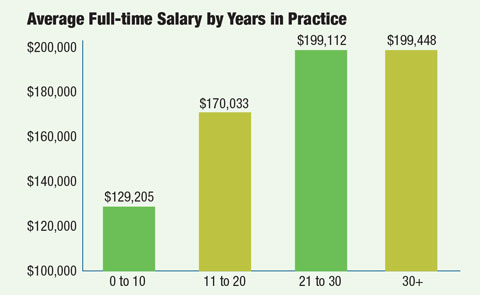 |
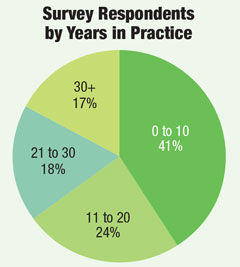 |
Increases Across the Board
Nearly all (90%) respondents work full-time, and they averaged a salary of $163,267, also a 9% increase from 2015. But 2016 was the year to work part-time, as the 10% of survey takers who work part-time had average earnings of $109,851, a whopping 34% higher than was reported by part-timers last year. The higher average seems to be a combination of factors instead of some mass exodus to part-time-hood by all the high-earners. Compared with last year, roughly 3% more have been in the field more than 20 years, and 6% more are practicing in the South—two factors that consistently lead to higher average salaries.
To Employ or Be Employed
Of all the demographics that can affect your pay, whether you are self-employed or not is the most important factor, as it could mean a swing of nearly 60%, according to this year’s survey. While the field of full-time respondents was split 50/50 between employed and self-employed, they were compensated quite differently. Self-employed ODs averaged $197,533, while employed ODs reported an average of $125,099—a 58% difference. Many self-employed survey takers also said they enjoyed the flexibility that comes with setting their own schedule.
 |
“I love the fact that I have the flexibility to run my own practice and have a beautiful place to work every day,” one survey taker says. “I am able to purchase the most up-to-date equipment and can practice to my highest potential.”
Given the huge pay gap and the lifestyle benefits, it’s surprising more ODs aren’t opening up shop for themselves. Yet, the challenges that come with being your own boss may make up for the difference in take-home. One survey taker said she made more before she owned her own business, while another said the cost of starting and growing a private practice from scratch took a giant chunk of profit out of his hands. Even after a practice is up and running, the headaches of ownership rarely ease up.
“Reimbursements from insurances are lower, cost of business operation is increased, so therefore income is lower despite efforts to cut costs and pursue marketing options,” one respondent said. “Fast service discount stores and online ordering by patients are eating into profits and income.”
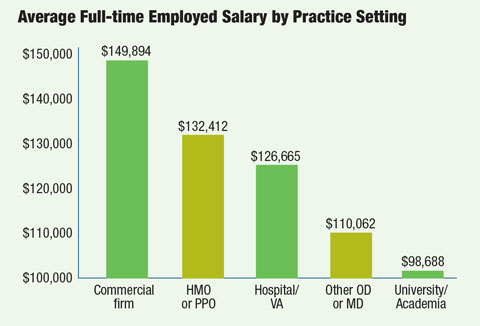 |
This respondent isn’t alone, which is why the ratio of employed to self-employed seems to remain steady from year to year. Yet, some go-getters feel the headaches are worth it and are ready for the challenge next year.
“I’m buying the practice, creating more incentives for staff and techs, and increasing online marketing,” one ambitious survey taker says. “I want to get reps more involved in displays and staff training and get more exposure to the community by involvement with health fairs, schools and an open house.” At least he knows the hard work will pay off in the end.
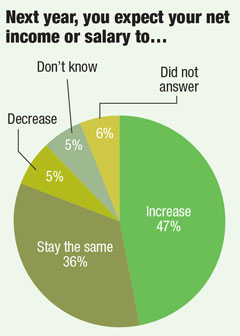 |
The Perks of Your Practice Setting
Perhaps the happy medium between juggling solo practice woes and skating by on an employee salary is joining a partnership or group. At least, the price is right. The 34% of self-employed ODs who work in a partnership or group setting reported the highest average salary of all, $234,267. A partnership also allows for specialization, which comes with its own perks.
“I own and operate an eye care practice that is partnered with a separate optical business,” one respondent said. “Thus, I only do eye care and no product sales, which makes my business a lot more manageable. Since the practice stays very busy and my overhead is low, my income is above average.”
No wonder nearly 30% of self-employed respondents said they are very satisfied with their income, compared with only 10% of employed survey takers.
But, for those who want to skip the hassle of self-employment altogether and still want to bring in the big bucks, working for a commercial firm is going to get you the closest with an average salary of $149,894.
While incredibly rewarding, working in academia provides the lowest reported full-time salary of $98,688. Only 2% of respondents work in a university setting, but more than half of them, 63%, are satisfied with their pay, citing better benefits, stability and the lack of weekend and on-call hours.
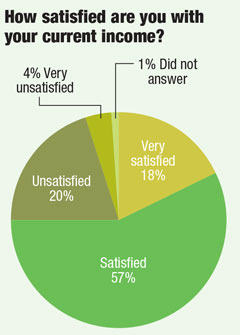 |
Time is Money
Another income-booster is time and the clinical experience that comes with it. Like last year, this year’s survey showed a continued trend of younger ODs in practice, with 41% of survey takers noting they have been in the field for 10 years or less. Those respondents have some financial rewards to look forward to, as experience pays. Respondents practicing for 20+ years averaged $198,636—54% more than those with at least 10 fewer years under their belt. Still, practitioners in the field for 10 years or less seem to be nearly as satisfied with their income as those with 20+ years of experience, 72% vs. 79%.
Of course, numbers can be deceiving. More than 70% of practitioners in the field for more than 20 years are self-employed. If you break down the stats, employed ODs practicing for 20+ years only average $144,317, while self-employed ODs in the field for the same time raked in an average of $219,671 this year.
The good news for those striving for that $200k mark? They might get there sooner, as the 41% of respondents practicing for less than a decade reported an average salary 10% higher than last year. And no matter the age, the key to salary satisfaction seems to be the same across all age groups: the ability to save for retirement.
“It is enough for me to pay my expenses and to save for retirement,” one respondent with more than 30 years of experience said.
“It provides a nice lifestyle, pays loans, allows for retirement savings and college savings,” another survey taker with less than 10 years of experience echoed.
Location, Location, Location
Where you have chosen to live and work could impact your income by as much as 16%, according to this year’s numbers. Like last year, respondents in the South reported the highest annual income of $177,612, a nice 7% increase from last year’s report.
This year, those in the West reported the lowest average, even in California ($153,684), where cost of living can be remarkably high. Not surprisingly, 34% of California ODs are unsatisfied or very unsatisfied with their pay.
“The current costs of business is too high living in California,” according to one respondent. “My salary does not match cost of living in California,” another said.
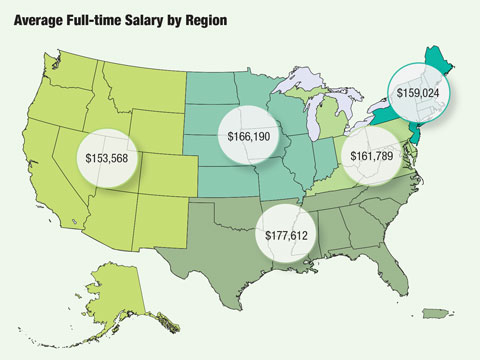 |
But salaries were on the rise in other parts of the country. Last year’s lowest earners, practitioners in the Mid-Atlantic and Lower Great Lakes region boosted their pay this year by about 14%, reporting an average salary hovering in the middle of the pack this year at $161,789: 5% more than those in the West, but 9% less that southern practitioners. ODs in the Midwest also reported a pay raise of about 11% compared with last year.
The Gap is Closing
Unfortunately, the gender gap continues to be an issue that impacts compensation. The good news is that it’s narrower than ever. Last year, men out-earned women by a shocking 68%. This year, the disparity is down to about 37%.
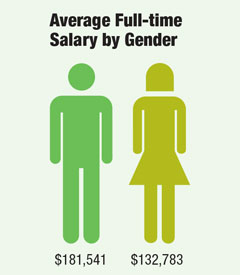 |
The gap isn’t consistent, however, and varies considerably based on years in practice. Men account for 93% of respondents in the field for more than 30 years, and they still report making, on average, 33% more than their female colleagues with the same experience (the same difference reported for this group in 2015). But it’s a different story for ODs in the field for less than 10 years. For one, men are no longer the majority—57% are women—and the pay gap narrows to just 3%. For once, our numbers suggest equal pay is just a few percentage points away for women optometrists entering the field.
Gearing up for 2017
Perhaps the narrowing gender gap is just one reason most respondents are hopeful for the year to come. About half of survey takers expect their salary to increase next year, and another 36% don’t think it will change at all.
Those gunning for more money have some tricks up their sleeves to make sure it happens, including specialization and improved efficiency.
“Our practice has improved in our EHR ability, allowing me to increase my patient per day volume and my per-patient revenue,” one respondent says. “New sources of revenue are improving our dry eye care and our diabetic care with continued MD referral through our clinical reports sent back to the primary care doctor, internist or endocrinologist. Maximizing both medical eye care revenue and profitability with contact lenses, frames and lenses allows our profession to thrive in a managed care environment.”
Many, however, will be looking to the tried-and-true revenue boosters, such as seeing more patients, raising fees, hiring more help or taking less time off. For some, 2017 will be the year of the job hunt to find a higher-paying position.
But for those who already have a good thing going, all they need to do is “continue providing memorable customer service,” one respondent says. After all, patient experience is everything.

